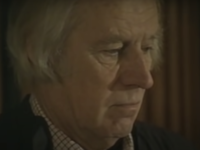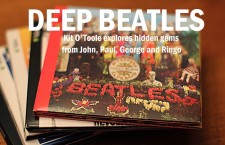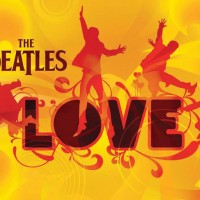It was nearly two and half minutes into 2012’s Produced by George Martin — during a friendly game of pool with son Giles — before you noticed the hearing aid in Martin’s ear. It was a devastating reality for music lovers of every kind.
George Martin, who gave us so many great sounds, could scarcely hear them anymore at the end of his life. Ever curious, ever involved, the legendary producer used to sit in the room with bands like the Beatles when they played — eyes closed, drinking in the sound, but forever damaging his hearing. “It was,” he told Ringo Starr at one point, “a kind of drug.”
Music, and in some respects only the music, was important to Martin. Produced by George Martin, an involving documentary issued by Eagle Rock, makes that clear. And it’s worth returning to, now that Martin has died at age 90.
Take the year 1963, when Martin-produced sides from the likes of Billy J. Kramer, Cilla Black and, of course, the Beatles spent some 37 straight weeks on the charts. “It was a treadmill, but it was a very nice one — a golden tread mill, you might say,” said Martin, born on January 3, 1926. Well, for EMI, anyway: He estimated that he was only making $2,000 a year. Martin said he didn’t even receive a Christmas bonus.
In fact, he made precious little money during his most celebrated period, but it never dampened George Martin’s enthusiasm for the work. “Would you say,” son Giles offered at one point, “you were the Simon Cowell of the 1960s?” The great producer replied, quickly: “Oh, I do hope not!”
Everything changed, for the Beatles and for George Martin, when the group decided to leave the road in 1966. Very quickly, the relationship deepened. “You were building,” Martin said, “a picture in sound.” They began toying with convention, as with the reversed vocal toward the end of John Lennon’s song “Rain.” “From that moment, he wanted everything backwards,” Martin said. “They all did.”
As Ringo Starr sat with Martin, listening to a playback of his titanic performance on “Tomorrow Never Knows,” played amidst flocks of tape-looped sounds, he enthuses: “This is the good reason we stopped touring and came into the studio.”
From the syncopated strings of “Eleanor Rigby,” to the brilliant dissonance of “Strawberry Fields Forever,” to the smooth orchestral fluidity behind “Something,” George Martin’s studio expertise became another instrument for the Beatles. “They were eternally curious,” Martin said of the foursome — though he just as well could have been talking about himself. “They wanted to find new ways of doing what they were doing — new harmonies, new endings to songs. They would always want to look beyond the horizon, not just at it.”
When, late into the 1960s, the Beatles began to lose that sense of adventure, to turn inward, the results were smaller for it.
Let It Be, an album project that began with John Lennon telling George Martin to take a more hands-off approach, was eventually handed over to the eccentric producer Phil Spector. Even in 2012, Martin described it as “a betrayal, really.” When presented with the finished product, Martin said he suggested that the sleeve read: “‘Produced by George Martin; overproduced by Phil Spector.’ But they didn’t seem to go for that.”
George Martin figured they would never work together again, and “I didn’t really want to.” But the quintet did, in fact, return to the studio — and to their previous glory, on 1969’s Abbey Road. That wasn’t the end of the story for Martin, even though the Beatles would soon go their separate ways.
“I, on the other hand,” he said, with a chuckle, “was liberated.”
Freed from chasing hits, having already been to the very top of the mountain again and again, George Martin branched out into the outer edges of his own imagination and then back again — working with both the fusion jazz band Mahavishnu Orchestra and the mainstream country-rockers America, both Jimmy Webb and Jeff Beck, Cheap Trick and Kenny Rogers. He built a studio in the Caribbean — later destroyed by Hurricane Hugo — where the Police, Elton John, Stevie Wonder, Dire Straits and his old friend Paul McCartney recorded in the 1980s.
“Everything is like that, though, isn’t it?” Martin said, walking around the ruins in Montserrat. “Everything has a period. You bring something out of nothing. But it always goes back to nothing again.”
Not everything, no. The records, those sounds — whether Martin could hear them unaided at the end, or not; even in his awful absence — will remain, forever.
- The Bright Spots in George Harrison’s Troubled ‘Dark Horse’ Era - December 29, 2024
- The Pink Floyd Deep Cut That Perfectly Encapsulates ‘The Wall’ - November 29, 2024
- Why Pink Floyd’s ‘The Endless River’ Provided a Perfect Ending - November 11, 2024





They were all liberated and reinvented themselves as individual artists.
Martin was very good at being a producer because he didn’t overdo it. He made all the Beatles radically different sounding concept-pieces fit into the same albums (can you believe it listening to their solo works?). The Beatles albums were always cutting-edge, and Martin kept up with technology with an open mind. He added the most tasteful and subtle touches. As an alternative, look at the (troubled) genius Phil Spector: he made Let It Be and John and George’s solo albums into demonstrations of his sound, with dated, muffling overproduction. Producers tend to think as well that they can make gold out of trash by surrounding it with their “sound.” Martin always talked of offering a quality product, and to this end, there was hardly ever room on a Beatles album for a dud, and their smash singles were known, quite uniquely, for their effectively double A sides, usually also left off their albums and strengthening the LP tracks. Producers should take after Martin and be great producers, instead of imparting a programmed formula to this or that track, “burying” mistakes and mediocrity in the mix.